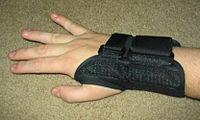
Photo from wikipedia
Exposure to ergonomic risk factors has been reported for laboratory workers over decades. However, these exposures are not well characterized with respect to the type of laboratory or work organization.… Click to show full abstract
Exposure to ergonomic risk factors has been reported for laboratory workers over decades. However, these exposures are not well characterized with respect to the type of laboratory or work organization. This study compared biomechanical exposure to upper extremity (UE) postures and hand activity levels (HALs) in general hospital laboratories by job, work, and laboratory type. The study used observational data gathered using a revised version of the Posture, Activity, Tools, and Handling (PATH) method, generating frequencies of categorized exposures. Eighteen workers were observed in 11 job titles (seven laboratories) in a single hospital by two investigators over a 7 month period. A taxonomy was constructed to categorize the extent to which the laboratory operations were automated. Overall, there were markedly high exposures to postural strain for the distal UE, especially wrist/forearm deviation (73% of observations), gross grasp (71%), and pinch grip (49%). For the HAL categories, 61% of the observations were in the moderate range (3.3–<6.7). Shoulders and elbows tended to remain in the neutral postural range. Posture frequencies were similar among the job categories studied and laboratory types. HAL was higher when the hand was in a pinch grip. Manual operations represented a higher proportion of work time than semi-automated or automated operations. Biomechanical exposure can be documented more extensively and diversely when using the revised PATH approach along with the taxonomy, with respect to exposure variables, such as the type of job, work, or organization in the industry including the hospital laboratories.
Journal Title: International Journal of Environmental Research and Public Health
Year Published: 2022
Link to full text (if available)
Share on Social Media: Sign Up to like & get
recommendations!